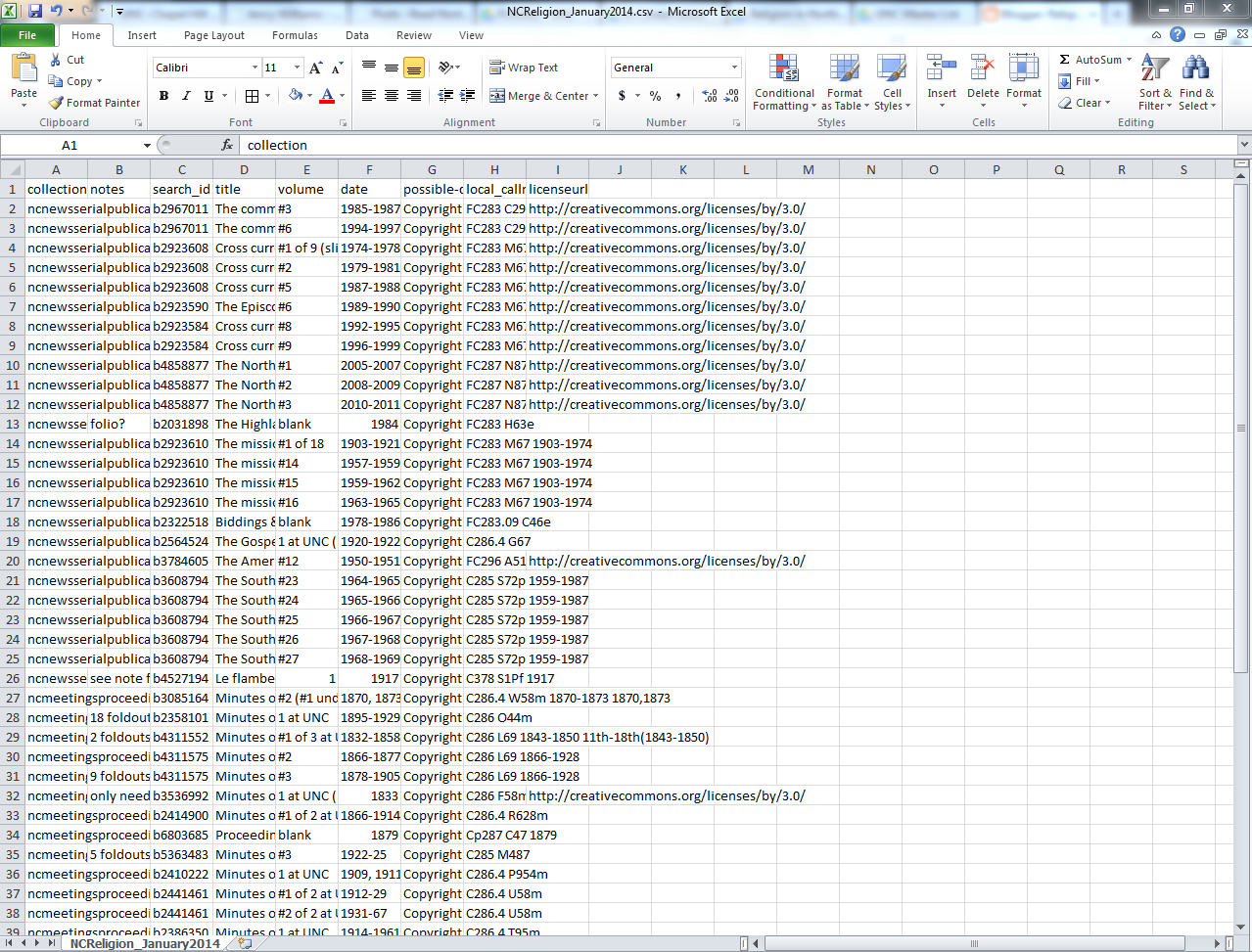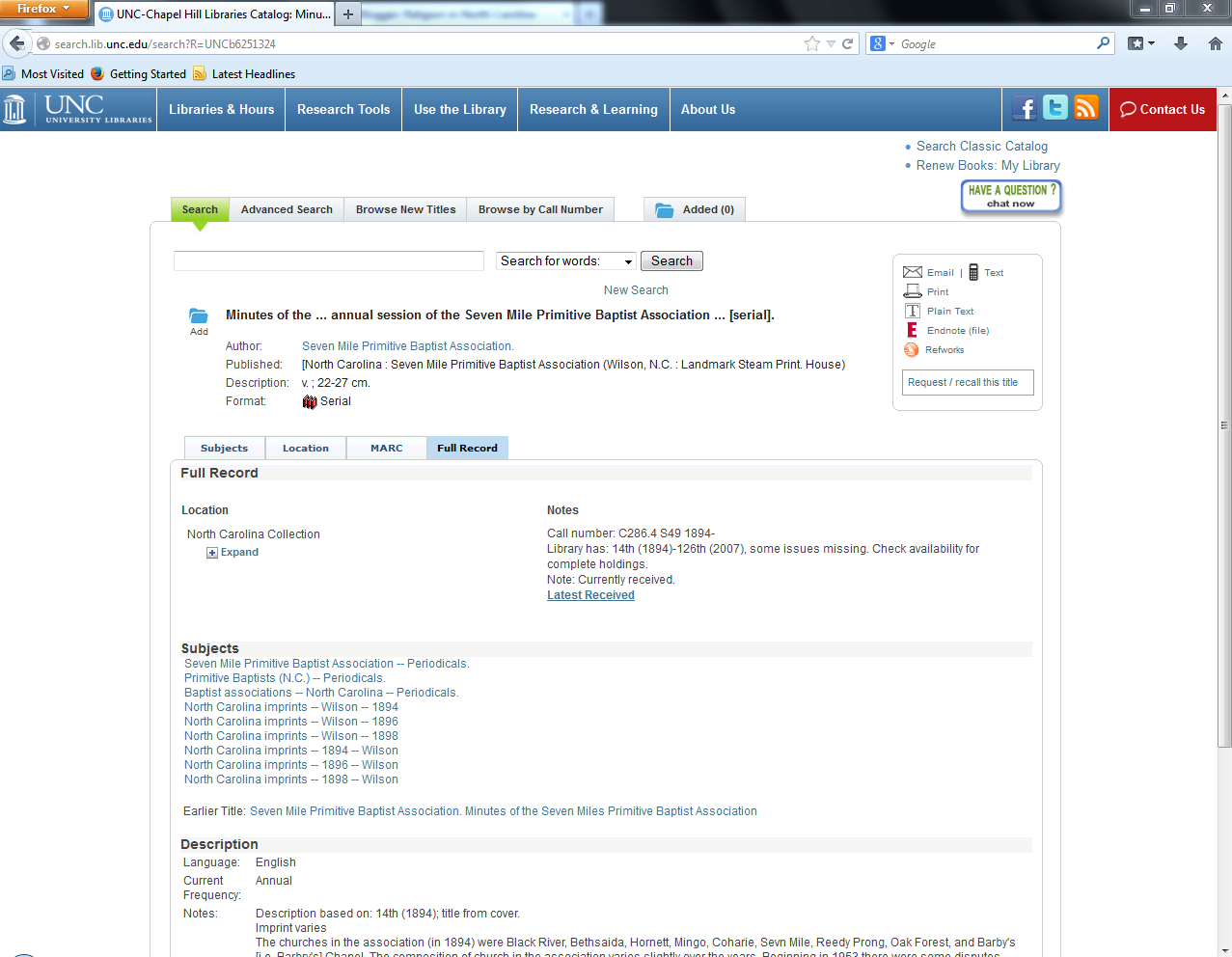Serials, more so than many other types of items, can be tricky to control. And that's putting it mildly. Take, for example, the case of the Seven Mile Primitive Baptist Association Minutes --
Recently, UNC has started to prepare minutes from the Seven Mile Primitive Baptist Association. Around the early 1950s, the group split into two organizations, however several years of both groups' minutes were bound together in the same physical volumes. There are three separate catalog records that correlate to this serial. Prior to digitization this decision was not a problem, but for the project, this physical constraint creates an intellectual limitation as well.
Often most of the materials are scanned in full. Sometimes though, the project only wants to include part of the item, for instance if the last several pages are blank, or if the volume in question contains several different items bound together. When assembling the monthly cart, the UNC student worker indicates this choice to the Digital Production Center (where the items are scanned, or digitized) simply by placing strips of paper representing where the Scribe operator should start and stop the scanning.
 |
| Click to expand |
A bib number is a seven-digit number preceded by UNCb- that serves as a unique identifier for items in the UNC Libraries system. Take a look at the URL of any catalog record and you'll see the bib number at the end of the address. You can search the UNC Libraries catalog by removing the "UNC" (ex: "UNCb6251324" becomes "b6251324") and typing the number into the either the main search bar on the UNC Libraries' home page or the Keywords search bar under Advanced Search. That bib number is important for the project's materials from UNC. Every item in the NC Religion Digital Collection has an Internet Archive entry, that entry contains the item's bib number, which links it back to the home library's catalog. Basically, for UNC, bib number equals catalog record. Duke and Wake Forest use similar identifiers for their materials, also called bib numbers.
 |
| Click to expand |
 |
| Click to expand |
In the case of the Seven Mile Primitive Baptist Associations, the idea of the bib number/catalog record is complicated because the two groups' minutes are bound together so that they are interspersed evenly (e.g., the two sets of minutes from, say, 1960, are placed one after the other) rather than divided to represent the two distinct groups. If the latter was true, then perhaps the project could have worked around the item's physical container by asking the Scribe operator to scan the first half as one Internet Archive entry and the second half as another Internet Archive entry.
That solution would be much neater. Each Internet Archive entry would contain the correct bib number and match its appropriate catalog record. Because of the physical arrangement of the volumes, the material must be scanned as it is. This is good in the sense that online users will see the item as it truly exists. But it is problematic as each Internet Archive entry can be assigned to a single bib number, and therefore single catalog record.
For the Seven Mile Primitive Baptist Association Minutes, that means that not only does the project have to scan the two groups' minutes together, it must also select one of two viable bib numbers: b6251324 and b6251334. How then can we convey that there are two distinct records of these two separate sets of minutes? With a digital collection, those of us involved in the project can't reach out and explain the materials to the users.
So what did we decide to do?
 |
| Click to expand |
 |
| Click to expand |
The third record, mentioned at the beginning of this post, is associated with a single set of minutes that is luckily unbound. The minutes from that year will be scanned separately and linked to its individual catalog record. UNC discovered additional sets of unbound minutes, which can be more freely assigned to the correct bib number.
One of our goals with this project, and as librarians in general, is to steer users in the correct direction of the information they are searching for. At times, that is easier said than done. When conflicts like this Seven Mile Primitive Baptist Association example arise, we do what we can to best outline the path to the materials. Digital collections, less directly mediated by librarians, provide new challenges. The concern is not always how to get the information into the hands of those who want it, but how to contextualize it.
No comments:
Post a Comment